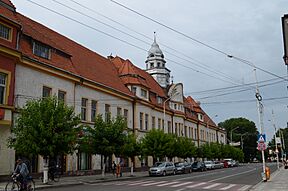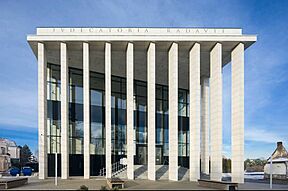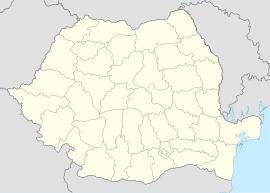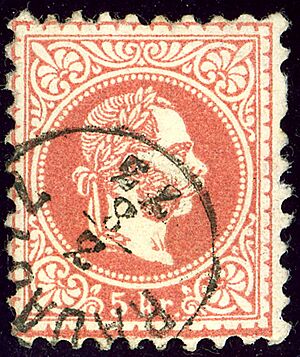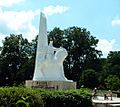Rădăuți facts for kids
Quick facts for kids
Rădăuți
|
||
|---|---|---|
|
Union Square in downtown Rădăuți
The Jewish Temple
The Orthodox Cathedral
Rădăuți Court
|
||
|
||

Location in Suceava County
|
||
| Country | ||
| County | Suceava | |
| Area | 32.30 km2 (12.47 sq mi) | |
| Elevation | 374 m (1,227 ft) | |
| Population
(2011)
|
Lua error in Module:Wd at line 1,575: attempt to index field 'wikibase' (a nil value). | |
| Time zone | EET/EEST (UTC+2/+3) | |
| Postal code |
725400
|
|
| Area code | (+40) 02 30 | |
Rădăuți is a historic town in Suceava County, located in north-eastern Romania. It is part of the beautiful historical region called Bukovina. Rădăuți is the second largest urban area in Suceava County, based on the 2021 census.
In 1995, Rădăuți was officially named a "municipality." This is a special title for larger, more important towns in Romania. It shares this title with two other cities in Suceava County: Fălticeni and Câmpulung Moldovenesc. The town covers an area of about 32.30 square kilometers. Before 1950, Rădăuți was the capital of the former Rădăuți County.
Contents
Discovering Rădăuți's Location
Rădăuți is found in the region of Bukovina. It sits on a flat area between two rivers, the Suceava and the Sucevița. The town is about 37 kilometers northwest of Suceava, which is the main city of the county.
Rădăuți is located in a valley, about 375 meters above sea level. It is one of the oldest settlements in the Moldavia region, with its history going back to the 15th century. Several nearby towns, like Siret, Solca, Milișăuți, and Vicovu de Sus, are also part of the Rădăuți area.
Who Lives in Rădăuți?
Rădăuți had its largest population in 1992, when over 31,000 people lived there. By 2016, it was the second most populated urban area in Suceava County, right after the county capital, Suceava.
According to the 2011 census, Rădăuți had 23,822 residents. Most people (about 97%) were ethnic Romanians. Other groups included Russians and Lipovans, Roma, Ukrainians, and Germans.
Most residents (about 83%) follow the Romanian Orthodox Christian faith. Other religions include Pentecostal (9.1%), Roman Catholic (3.1%), and a smaller number of Greek-Catholic and Baptist followers.
A Look at Rădăuți's Past
The first time Rădăuți was likely mentioned was in a document from 1392. It talked about "Radomir's village." This is believed to be where the name Rădăuți came from. Some people think the town is even older, with its name possibly coming from a Latin word used by Roman soldiers. The oldest clear mention of Rădăuți by its current name is from 1413, in a document by Prince Alexandru cel Bun of Moldavia.
By the mid-1300s, Rădăuți was already a busy place. It was home to an important Eastern Orthodox church during the time of Bogdan I (1359–1365). Later, it became a bishopric, which is an area managed by a bishop.
Rădăuți was allowed to hold special fairs, which helped it grow. Its location was perfect, halfway between the Carpathian Mountains and the flatlands. This allowed traders from both areas to meet and do business. These fairs were happening even during the time of Stephen the Great (around 1481).
The town has a cathedral built in 1402, where several Moldavian princes are buried. Rădăuți was also the center of a Greek bishopric, which moved to Chernivtsi in 1786.
During the time of Habsburg rule (1775–1918), Rădăuți was one of the largest cities in the Duchy of Bukovina. Many German people, especially Swabians, moved there during this period. They formed the group known as the Bukovina Germans.
Jewish History in Rădăuți
A Jewish community lived in Rădăuți even before the Habsburgs took over. They had some self-governance and experienced a time of growth and cultural activity in the 1800s.
Sadly, most of Rădăuți's Jewish population faced terrible events during the Holocaust. Starting around 1938, Jewish people were treated badly by authorities. In October 1941, over 10,000 Jewish residents of Rădăuți were forced to leave their homes. They were sent to camps in a region called Transnistria Governorate.
Bogdana Monastery
The Princely Church at Rădăuți is part of the Bogdana Monastery. It holds the graves of important rulers of Moldavia, including Bogdan I and his son Lațcu, and later, Roman I of Moldavia. This monastery is the oldest in Moldova and Bucovina, dating back to 1365. Inside, there are 14 tombs, including those of Bogdan I (1359–1365), Lațcu Voievod (1365–1373), and Roman I (1391–1394).
Rădăuți's Sister Cities
Rădăuți has "twin towns" or "sister cities" around the world. These are cities that have friendly partnerships to promote cultural exchange and understanding.
 Beilstein, Germany
Beilstein, Germany Pontault-Combault, France
Pontault-Combault, France Drochia, Moldova
Drochia, Moldova Briceni, Moldova
Briceni, Moldova Caminha, Portugal
Caminha, Portugal Gliwice, Poland
Gliwice, Poland Kyrenia, Cyprus
Kyrenia, Cyprus Ragusa, Italy
Ragusa, Italy
Famous People from Rădăuți
Many notable individuals were born or grew up in Rădăuți, including:
- Avigdor Arikha - An Israeli painter.
- Emil Armin - An American artist.
- Alexandru Bodnar - An athlete.
- Heinrich Gärtner - A cinematographer.
- Emanuil Grigorovitza - A writer.
- Irina Lauric - A sprint canoeist.
- Iacov Putneanul - A Metropolitan (a high-ranking church leader).
- Saint Bishop Leontie of Rădăuți - A respected religious figure.
- Benedict Menkes - A Romanian biologist.
- Dan Pagis - An Israeli Hebrew poet and literature researcher.
- Lothar Rădăceanu - A journalist, linguist, and politician.
- Ștefan Rusu - An Olympic champion in Greco-Roman wrestling.
- Matei Vișniec - A Romanian poet and playwright who lives in France.
Images for kids
See Also
 In Spanish: Rădăuți para niños
In Spanish: Rădăuți para niños


